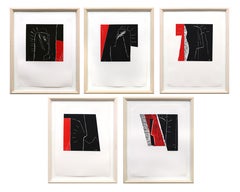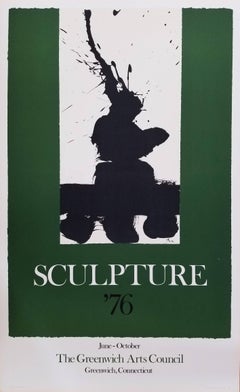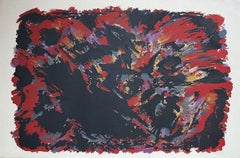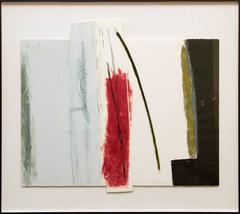Dale Chisman Abstract Prints
American, 1943-2008
Dale Chisman graduated from the University of Colorado at Boulder with a Master’s in Fine Arts degree. He lived and worked in New York between 1969–84. During this time, his work was displayed in several exhibitions, including one at the Brooklyn Museum. In 1985, Chisman returned to Colorado, where he continued to actively work and exhibit his art until he died in 2008.
to
1
Overall Width
to
Overall Height
to
1
2
636
206
165
162
1
1
1
1
1
1
1
Artist: Dale Chisman
Group of 5 1980s Abstract Lithographs, Red & Black American Modern Art Prints
By Dale Chisman
Located in Denver, CO
This striking group of five abstract lithographs, signed and individually titled by renowned artist Dale Chisman, was created in 1987. The lithographs feature a captivating mix of re...
Category
1980s Abstract Dale Chisman Abstract Prints
Materials
Lithograph
Related Items
Greenwich Arts Council Poster /// Abstract Expressionist Robert Motherwell NY
By Robert Motherwell
Located in Saint Augustine, FL
Artist: Robert Motherwell (American, 1915-1992)
Title: "Greenwich Arts Council"
*Issued unsigned, though signed by Motherwell in the plate (printed signature) center right
Year: 1976
Medium: Original Lithograph, Exhibition Poster on Strathmore paper
Limited edition: 700. (There was also a signed and numbered edition of 42)
Printer: Tyler Graphics, Ltd., Mount Kisco, NY
Publisher: Greenwich Arts Council, Greenwich, CT
Reference: "The Prints of Robert Motherwell - A Catalogue Raisonné 1943-1984" - Belknap Appendix: No. 28, page 282; "Robert Motherwell - The Complete Prints 1940-1991" - Engberg No. 202
Sheet size: 37.25" x 23"
Condition: Never framed, has been professionally stored away for decades. Some minor edge wear. In excellent condition
Rare
Notes:
Printed in three colors: black, green, and cream. Poster produced for a special exhibition "Sculpture 76" at The Greenwich Arts Council, Greenwich, CT from June - October, 1976. The image featured on this poster is Motherwell's 1972 acrylic painting on paper "Greenwich Sculpture". Artist's copyright lower left and printer's imprint lower right.
GIA Gallery Poster Disclaimer:
Not to be confused with thousands of contemporary inkjet/giclée/digital reproductions ignorantly or deliberately passed off as originals on the market today. The examples we offer here are the original period vintage (exhibition) posters, created and designed by, or under the supervision and authorization of the artist or their respective estate (posthumously), for various exhibitions and events in which they participated. If applicable, this poster is also fully documented within its respective artists' official catalogue raisonné of authentic graphic works, prints, and or posters.
Biography:
Robert Motherwell was born January 24, 1915, in Aberdeen, Washington. He was awarded a fellowship to the Otis Art Institute in Los Angeles at age 11, and in 1932 studied painting briefly at the California School of Fine Arts in San Francisco. Motherwell received a B.A. from Stanford University in 1937 and enrolled for graduate work later that year in the Department of Philosophy at Harvard University, Cambridge, Massachusetts. He traveled to Europe in 1938 for a year of study abroad. His first solo show was presented at the Raymond Duncan...
Category
1970s Abstract Expressionist Dale Chisman Abstract Prints
Materials
Lithograph
The Burgos II trial
By Alfred Manessier
Located in Paris, FR
Lithograph, 1971
Edition : XIII/XVIII
Publisher : Galerie de France (Paris)
Printer : Mourlot (Paris)
77.50 cm. x 118.50 cm. 30.51 in. x 46.65 in. (paper)
71.50 cm. x 105.50 cm. 28...
Category
1970s Abstract Dale Chisman Abstract Prints
Materials
Lithograph
Susan Sheehan Gallery (Ellsworth Kelly Posters 1951-2001) Poster (Signed) Color
By Ellsworth Kelly
Located in Saint Augustine, FL
Artist: Ellsworth Kelly (American, 1923-2015)
Title: "Susan Sheehan Gallery (Ellsworth Kelly Posters 1951-2001)"
*Signed by Kelly in pencil lowe...
Category
Early 2000s Abstract Geometric Dale Chisman Abstract Prints
Materials
Lithograph
Ellsworth KellySusan Sheehan Gallery (Ellsworth Kelly Posters 1951-2001) Poster (Signed) Color, 2001
$2,800
H 36.63 in W 27.13 in
MARAVILLAS CON VARIACIONES... Lithograph Contemporary Art Abstract Black Green
By Joan Miró
Located in Madrid, Madrid
Maravillas con variaciones acrósticas en el jardín de Miró XI
Date of creation: 1975
Medium: Lithograph on Gvarro paper
Edition: 1500
Size: 49,5 x 71 cm
Observations: Lithograph on G...
Category
1970s Abstract Dale Chisman Abstract Prints
Materials
Lithograph
$1,169
H 19.49 in W 27.96 in
Joan Miró - MARAVILLAS CON VARIACIONES... Lithograph Contemporary Art Abstract
By Joan Miró
Located in Madrid, Madrid
Joan Miró - Maravillas con variaciones acrósticas en el jardín de Miró XVIII
Date of creation: 1975
Medium: Lithograph on Gvarro paper
Edition: 1500
Size: 49,5 x 35,5 cm
Observations...
Category
1970s Abstract Dale Chisman Abstract Prints
Materials
Lithograph
$934
H 19.49 in W 13.98 in
Joan Miró - MARAVILLAS CON VARIACIONES... Lithograph Contemporary Art Abstract
By Joan Miró
Located in Madrid, Madrid
Joan Miró - Maravillas con variaciones acrósticas en el jardín de Miró VI
Date of creation: 1975
Medium: Lithograph on Gvarro paper
Edition: 1500
Size: 49,5 x 35,5 cm
Observations: L...
Category
1970s Abstract Dale Chisman Abstract Prints
Materials
Lithograph
$934
H 19.49 in W 13.98 in
Joan Miró - MARAVILLAS CON VARIACIONES... Lithograph Contemporary Art Abstract
By Joan Miró
Located in Madrid, Madrid
Joan Miró - Maravillas con variaciones acrósticas en el jardín de Miró XVII
Date of creation: 1975
Medium: Lithograph on Gvarro paper
Edition: 1500
Size: 49,5 x 35,5 cm
Observations:...
Category
1970s Abstract Dale Chisman Abstract Prints
Materials
Lithograph
$934
H 19.49 in W 13.98 in
Untitled (Fresh Air School) /// Contemporary Abstract Expressionist Walasse Ting
By Walasse Ting
Located in Saint Augustine, FL
Artist: Walasse Ting (Chinese-American, 1929-2010)
Title: "Untitled (Fresh Air School)"
Portfolio: Fresh Air School
*Unsigned edition
Year: 1972
Medium: Original Lithograph on white ...
Category
1970s Abstract Expressionist Dale Chisman Abstract Prints
Materials
Lithograph
Polyphony
By Sonia Delaunay
Located in Paris, FR
Lithograph, 1971
Handsigned by the artist in pencil and numbered 17/125
56.00 cm. x 76.00 cm. 22.05 in. x 29.92 in. (paper)
47.50 cm. x 69.50 cm. 18.7 in. x 27.36 in. (image)
Arc...
Category
1970s Abstract Dale Chisman Abstract Prints
Materials
Lithograph
Don Quichotte
By Bernard Buffet
Located in Paris, FR
Lithograph, 1989
Edition : /200
Publisher : Galerie Maurice Garnier (Paris)
Printer : Mourlot (Paris)
75.50 cm. x 57.50 cm. 29.72 in. x 22.64 in. (paper)
66.00 cm. x 50.00 cm. 25.9...
Category
1980s Abstract Dale Chisman Abstract Prints
Materials
Lithograph
Alexander Calder 'Albi' Limited Edition, Signed Print
By Alexander Calder
Located in San Rafael, CA
Alexander Calder (American, 1898-1976),
'Albi', 1969
Lithograph in colors
Pencil signed lower right
Edition 94/100
Sheet: 35.25 x 25 inches
In a vintage acrylic box...
Category
1960s Abstract Dale Chisman Abstract Prints
Materials
Lithograph
$6,750
H 35.5 in W 25.5 in D 1.5 in
Rythme-couleur - Hand-signed and numbered original lithograph, 1962
By Sonia Delaunay
Located in New York, NY
Sonia Delaunay
Rythme-couleur, 1962
Lithograph on Fabriano wove paper
27 3/5 × 19 7/10 in l 70.2 × 50 cm
Frame included - 32 1/3 x 24 4/5 l 83 x 63 cm
Edition of 40
Condition: Overa...
Category
1960s Abstract Geometric Dale Chisman Abstract Prints
Materials
Lithograph
$4,500
H 27.64 in W 19.69 in
Previously Available Items
Untitled 1/1
By Dale Chisman
Located in Denver, CO
Monotype/mixed media paper collage, signed lower right and numbered 1 of 1, lower left. Housed in a custom black frame with archival materials and AR Glass (UV Protection/Anti-refle...
Category
Late 20th Century Abstract Dale Chisman Abstract Prints
Materials
Monotype
Dale Chisman abstract prints for sale on 1stDibs.
Find a wide variety of authentic Dale Chisman abstract prints available for sale on 1stDibs. You can also browse by medium to find art by Dale Chisman in archival paper, lithograph, paper and more. Much of the original work by this artist or collective was created during the 1980s and is mostly associated with the abstract style. Not every interior allows for large Dale Chisman abstract prints, so small editions measuring 23 inches across are available. Customers who are interested in this artist might also find the work of Peter Voulkos, Nancy Graves, and Gene Davis. Dale Chisman abstract prints prices can differ depending upon medium, time period and other attributes. On 1stDibs, the price for these items starts at $4,750 and tops out at $4,750, while the average work can sell for $4,750.



